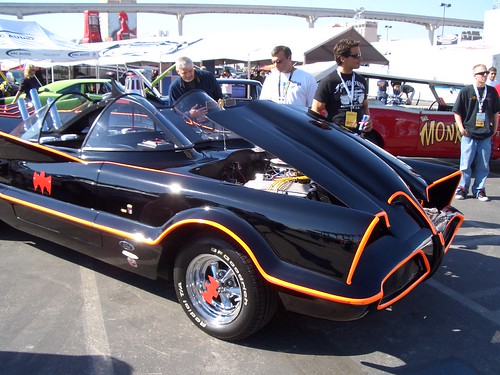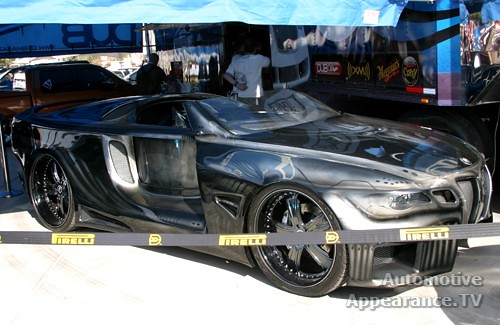
Hamann BMW Tycoon
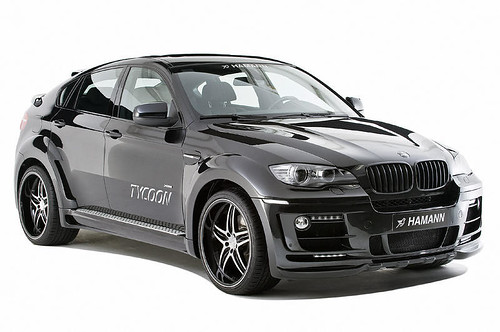
Audi R8 Modified Car version
Optimized Performance
The stage 1 kit produces an increase power output of the original motor from 309kw/420hp to 348kw/460hp and increases torque from 430Nm/317lb-ft to 465Nm/343lbs-ft. A performance kit with durable components designed by PPI consists of corrosion resistant stainless steel sport rear muffler with throttle system. Just beginning at low-end torque, the resulting sound signals pure power, but with high speeds one experiences an even more imposing sound. Matched to this is a complete optimised engine management plus sport air filter providing the unit with extra breathing abilities. Results are a top speed of 192 mph (311 km/h) and sprinting from 0-60 mph in only 4,0 seconds; a six-tenths decrease versus standard production.

Aerodynamics
MAG9 Lightweight Wheels
The new PPI MAG9 wheel design characterises the connection of high technical demands to sporty elegance. The two-part magnesium wheel with nine spokes and a wheel rim of carbon fibre commands not only by its exclusive look, but also through its outstanding craftsmanship setting new benchmark standards in the Audi tuning arena. The offered PPI MAG9 comes in dimension 9 x 19 front and 11 x 19 rear. Through the use of ultra light material magnesium resulting in reduction of unsprung mass, acceleration as well as deceleration and handling are distinctly improved. Weighing a mere 7,8 kg for front axle rims and 8,2 kg for rear axle rims, the PPI wheel are absolute champions in the lightweight arena. Optimal tires developed for the PPI R8 Razor in cooperation with Michelin are the supplied Michelin Pilot Sport Cup in dimensions 235/35 ZR19 (front) and 305/30 ZR19 (rear).
Interior
To complete the exclusive enhancements of the R8, PPI offers extensive modifications in materials and parts to the original interior. PPI offers handbrake, door entry threshold plates and middle instrument panel in carbon fibre. The technical highlight of the interior is the new PPI designed ergonomic steering wheel (available with Carbon Fibre sections) with additional interface controls for its driving dynamical program. Offered on special request is a personalized floor mat set furnished with leather trim. Also available is complete hand crafted precision leather, suede, alcantara upholstery from our in-house saddlers.
Car and Motorcycle Modification Contest

Mercy E 200 K Gusur Nissan Cedric dan Toyota Crown

Car Modification Contest
 Car Modification Contest
Car Modification Contest Car Modification Contest
Car Modification Contest Car Modification Contest
Car Modification Contest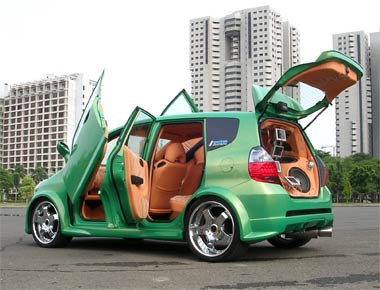 Car Modification Contest
Car Modification Contest Car Modification Contest
Car Modification ContestGAMBAR MODIFIKASI SUZUKI SWIFT 2009


KONTES MODIFIKASI HONDA JAZZ EXTREAM
 modifikasi honda jazz contest
modifikasi honda jazz contestConnect the success of the Jazz Tuning Contest is held in the year 2005, PT Honda Prospect Motor (HPM) to hold back the third time the event "Jazz Tuning Contest 2007" in the Main Atrium Mall Taman Anggrek, Jakarta, from 28 June to 1 July 2007 . This event is an event contest modifications for users Honda Jazz mania for the creativity and innovation in modifying their cars.
Pimped Out Car
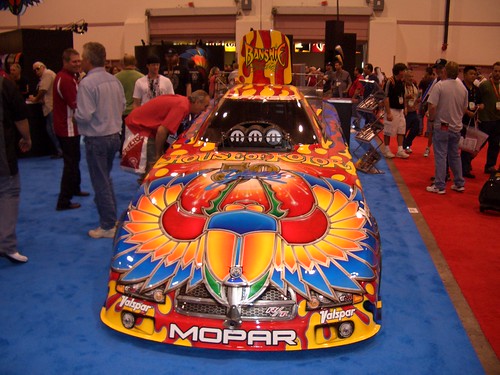
That’s either an impressive paint job, or an eye sore…kinda depends on how much you like the colors.

Rolls-Royce Phantom $320,000

Lamborghini Murcielago $279,900

Aston Martin Vanquish $255,000

The Aston Martin V12 Vanquish is a supercar manufactured by Aston Martin since 2001. It rose to fame after being featured as the official James Bond car in Die Another Day, the twentieth James Bond film. In the film, the Vanquish has the usual Bond film embellishments, including active camouflage which rendered the vehicle virtually invisible. The Vanquish is powered by a 5.9 L (5935 cc) 48-valve 60° V12 engine, which produces 343 kW (460 hp) and 542 N·m (400 ft·lbf) of torque. It is controlled by a fly-by-wire throttle and a 6 speed 'paddle shift' or semi-automatic transmission. A special V12 Vanquish S debuted at the 2004 Paris Auto Show with the power upped to 388 kW (520 hp) and 577 N·m (426 ft·lbf).
2010 the Scion TC (touring coupe)


Honda FC Sport






 Honda FC Sport concept is the latest concept from Honda that has been unveiled at Los Angeles Auto Show.
Honda FC Sport concept is the latest concept from Honda that has been unveiled at Los Angeles Auto Show.Honda FC Sport aims the display the flexibility and potential of Honda’s V Flow fuel cell technology, already in use on the FCX Clarity.
Honda FC Sport concept is a three-seat sports car hydrogen-powered design study model that inspired by supercar levels of performance, a low center of gravity, a powerful electric motor and zero emissions.
Honda FC Sport’s low center of gravity is obtained by using a modular approach to fuel cell component packaging.
The FC Sport emphasizes the design flexibility and potential of Honda’s V Flow fuel cell technology - already deployed in the Honda FCX Clarity sedan - and reconfigures it into a lightweight sports car design with an ultra-low center of gravity, powerful electric motor performance and zero-emissions. The design study concept is inspired by supercar levels of performance through low weight and a high-performance, electrically driven fuel cell powertrain.
“The Honda FC Sport explores how to satisfy automotive performance enthusiasts in a world beyond petroleum,” said Dan Bonawitz, vice president of American Honda Motor Co., Inc. “People who love sports cars will still have a reason to love in a hydrogen-powered future.”
The high-output Honda fuel cell powertrain and a sleek, aerodynamic body contribute to the vehicle’s performance potential. A modular approach to fuel cell component packaging and the electric drivetrain contribute to the FC Sport’s low center of gravity with the majority of vehicle mass distributed between the axles, creating the balanced weight distribution sought after in sports cars.
The ideal placement of the Honda V-Flow fuel cell stack and related components demonstrates the benefits of a platform-specific, hydrogen-powered fuel cell powertrain. The Honda FC Sport is configured to accommodate a custom-formed high-power fuel cell stack, located between the rear seats, and a battery pack placed low in the middle of the vehicle. The electric motor resides just forward of the rear axle. Two fuel storage tanks, visible from above, are located above the rear axle.
The optimal placement of fuel cell components for performance also allows for a relatively large passenger cabin by conventional supercar standards with enough space for three seating positions. The interior layout focuses primarily on the driver with a racecar-like center driving position. The enclosed canopy opens upward from the rear to allow for entry and exit. Two rear passenger seats flank the driver’s left and right side.
The glacier white body color conveys the Honda FC Sport’s clean environmental aspirations while the dark wheels and deeply tinted glass provide a symbolic contrast befitting of the vehicle’s unique combination of clean power and high performance. Green construction techniques further contribute to a reduced carbon footprint. An organic, bio-structure theme is carried through to the body construction where exterior panels are intended to use plant-derived bio-plastics.
The sleek, low-profile body is designed to convey a high-technology appearance with sculpting that combines angular shapes in the front of the vehicle that taper into geometric, hex forms in the rear. The rear hex forms house cooling radiators for the fuel cell. Formula 1-style barge boards behind the front wheels enhance high speed aerodynamics and convey the vehicle’s racing pedigree. The hydrogen storage tanks, visible from the rear deck, showcase the FC Sports fuel cell technology in much the same way that a “naked bike” motorcycle showcases its engineering technology.
Volkswagen GTI Impressive Cars
 2010 Volkswagen GTI Impressive Cars
2010 Volkswagen GTI Impressive Cars 2010 Volkswagen GTI Beautifull Cars
2010 Volkswagen GTI Beautifull CarsBentley Continental Supersports Interior
 2010 Bentley Continental Supersports Rear View
2010 Bentley Continental Supersports Rear View 2010 Bentley Continental Supersports Luxury Car
2010 Bentley Continental Supersports Luxury Car2010 Zenvo ST1 Super Car
 2010 Zenvo ST1 Super Car
2010 Zenvo ST1 Super Car 2010 Zenvo ST1 Great Car
2010 Zenvo ST1 Great Car 2010 Zenvo ST1 Top Sport Cars
2010 Zenvo ST1 Top Sport Cars
